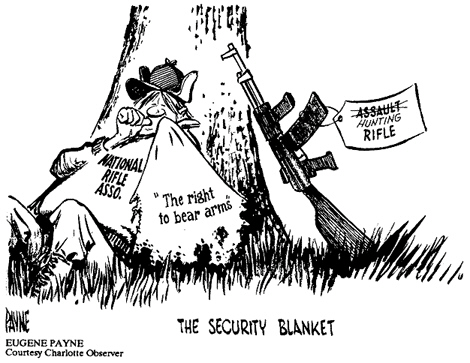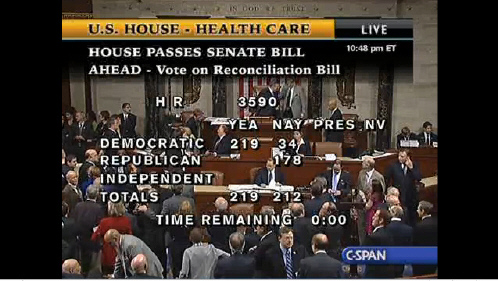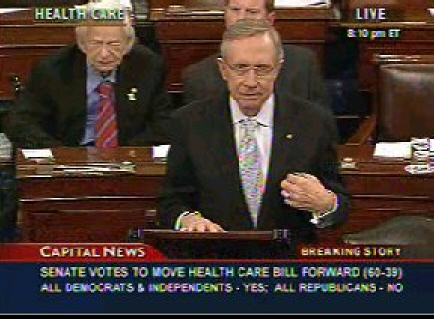Multiple Choice
Identify the
choice that best completes the statement or answers the question.
|
|
|
1.
|
What is the tactic of delaying a vote with debate in the Senate until the
majority party withdraws the bill and changes it to the minority’s liking?
a. | filibustering | c. | gabling | b. | voice voting | d. | cloture |
|
|
|
2.
|
Senators can end a filibuster by a three-fifths vote (60 senators) to bring
about what?
a. | pigeonholing. | c. | cloture. | b. | a voice vote. | d. | a roll-call
vote. |
|
|
|
3.
|
City councils usually approve the city budget and pass what type of laws?
a. | commissions. | c. | bylaws. | b. | ordinances. | d. | city charters. |
|
|
|
4.
|
If the president ignores a bill for 10 days and Congress is not in session, what
word is used?
a. | filibuster. | c. | pocket veto. | b. | line item veto. | d. | slate bill. |
|
|
|
5.
|
What type of court order requires police to explain to a court why they are
holding a prisoner?
a. | rider | c. | writ of habeas corpus | b. | bill of
attainder | d. | casework |
|
|
|
6.
|
People who live a representative’s district are called his or her
____________. People who live in the 10th congressional district of Virginia are Rep. Frank
Wolf’s ______________.
a. | lobbyists. | c. | cloture. | b. | constituents. | d. | representees. |
|
|
|
7.
|
What terms refers to a population count taken every 10 years used to decide on
the boundaries of congressional districts?
a. | constituent | c. | census | b. | cloture | d. | habeas corpus |
|
|
|
8.
|
What is the term that is used when an official is formally accused of misconduct
in office?
a. | cloture | c. | impeach | b. | censure | d. | habeas corpus |
|
|
|
9.
|
What is the term for the help that Congress members give constituents in dealing
with the federal government?
a. | pork-barrel projects | c. | franking | b. | casework | d. | filibustering |
|
|
|
10.
|
Who is the person who usually acts as chairperson of the Senate?
a. | President of the United States | c. | filibuster | b. | majority
leader | d. | majority
whip |
|
|
|
11.
|
Congress may not pass ____ laws, or laws that make an act a crime after the act
has been committed.
a. | casework | c. | filibuster | b. | ex post facto | d. | cloture |
|
|
|
12.
|
What powers are shared by the state governments and the federal
government?
a. | militia | c. | reserved | b. | national | d. | concurrent |
|
|
|
13.
|
Private special interest groups hire these people to influence government
decision makers.
a. | lawyers | c. | filibusters | b. | clotures | d. | lobbyists |
|
|
|
14.
|
In this image, both the House and Senate have gathered to listen to President
Obama in 2009. Which term would best be used to describe this type of event? a. | Emergency session | c. | Bipartisanship | b. | joint session | d. | Conference
Committee |
|
|
|
15.
|
Name the privilege allows Congress members to send mail without paying
postage.
a. | franking | c. | postal | b. | casework | d. | rider |
|
|
|
16.
|
What term, also called “earmarks,” refers to government projects and
grants that benefit a Congress member’s home state?
a. | pork-barrel projects | c. | cloture grants | b. | filibusters | d. | fat money |
|
|
|
17.
|
What is another name for Clause 18, the “necessary and proper”
clause?
a. | writ of habeas corpus | c. | filibuster | b. | bill of attainder | d. | elastic clause |
|
|
|
18.
|
Certain groups try to influence government decisions. Look at the cartoon. What
type of groups are shown as trying to get laws passed that support their group’s
viewpoint?  a. | Special-interest groups | c. | Committees | b. | Public
bills | d. | Constituents |
|
|
|
19.
|
A ____ committee is temporary, created to do a special job for a limited
period.
a. | joint | c. | select | b. | standing | d. | conference |
|
|
|
20.
|
The most powerful member of the House of Representatives is the
a. | majority whip. | c. | Speaker of the House. | b. | President of the
House. | d. | majority
leader. |
|
|
|
21.
|
Refer to the image below. You can see the borders of these districts are drawn
in a way that helps or hurts a certain group. What is the term for an oddly shaped district designed
to increase the voting strength of a particular group? a. | Precinct | c. | Ward | b. | Unfair | d. | Gerrymander |
|
|
|
22.
|
What are completely unrelated (non-germane) amendments tacked onto a Senate
bill?
a. | pigeonholes | c. | joint resolutions | b. | riders | d. | baggage |
|
Matching
|
|
|
|
|
|
23.
|
Step 9
|
|
|
24.
|
Step 8
|
|
|
25.
|
Step 6
|
|
|
26.
|
Step 10
|
|
|
27.
|
Step 7
|
|
|
|
|
|
28.
|
Step 3
|
|
|
29.
|
Step 4
|
|
|
30.
|
Step 2
|
|
|
31.
|
Step 5
|
|
|
32.
|
Step 1
|
Essay: Honors choose 2 questions - answer in complete
sentences.
|
|
|
33.
|
The images below show the vote on the Health Care Reform Bill in the House of
Representatives and in the Senate in 2009. Look carefully at the images. In your own words, state how
the legislative process (the process of lawmaking) reflects the principles of American
democracy.  
|